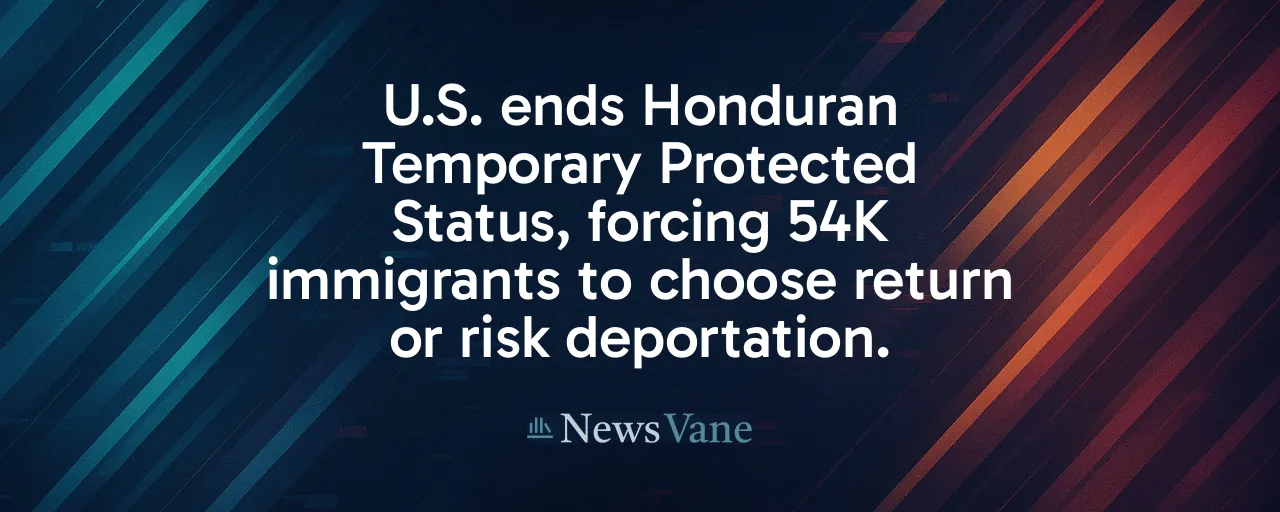A Sudden Shift for Honduran Immigrants
On July 7, 2025, the U.S. Department of Homeland Security announced the end of Temporary Protected Status for Honduras, a program that has shielded roughly 54,000 Hondurans from deportation since 1999. The decision, effective 60 days after its Federal Register notice, marks a turning point for immigrants who have lived in the United States for over 25 years. Families now face tough choices: return to Honduras, seek other legal pathways, or risk staying without status.
The announcement cites Honduras' recovery from Hurricane Mitch, which devastated the country in 1998 and prompted the original TPS designation. Secretary Kristi Noem emphasized that improved infrastructure and government programs signal the nation's readiness to welcome returnees. However, the abrupt change raises questions about the broader implications for immigrants, their communities, and the U.S. economy.
Roots Run Deep in American Communities
Honduran TPS holders have deep roots in the United States. Many have lived in the United States for over 25 years, raising 53,000 U.S.-citizen children and contributing to local economies. Research shows these workers, employed in construction, childcare, hospitality, and healthcare, generate $4.5 billion in annual wages and support up to $45 billion in GDP over a decade. Their departure could disrupt industries already facing labor shortages.
Beyond economics, the social fabric of communities with large Honduran populations stands to fray. Family separations loom large, with U.S.-citizen children facing the prospect of leaving their home or losing a parent. Local schools, churches, and businesses brace for the ripple effects of displacement, while advocates warn of psychological stress on families caught in limbo.
Honduras' Recovery: A Mixed Picture
The decision hinges on Honduras' progress since Hurricane Mitch. The Department of Homeland Security highlights rebuilt infrastructure and poverty-reduction programs under President Xiomara Castro, while offering repatriation incentives such as free airfare and a $1,000 resettlement bonus through the CBP Home app. These steps suggest a nation capable of reintegrating its citizens, bolstered by job training and economic aid programs.
However, challenges persist. Studies highlight ongoing gang violence, corruption, and a 64 percent poverty rate, raising concerns about safety and opportunity for returnees. The United Nations refugee agency notes internal displacement and protection gaps, suggesting Honduras' recovery, while notable, remains fragile. These realities complicate the narrative of a straightforward homecoming.
Economic Stakes on Both Sides
The termination carries hefty economic consequences. In the United States, employers face $233 million in turnover costs as TPS workers leave, while sectors like construction and healthcare lose reliable labor. Social Security and Medicare stand to lose over $135 million annually in contributions. Local economies, particularly in states with high TPS populations, could see reduced demand as families relocate or scale back spending.
For Honduras, the stakes are equally high. Remittances from TPS holders account for nearly 20 percent of the nation's GDP. A sudden drop could strain families and destabilize the economy, potentially spurring more migration. While repatriation programs aim to ease the transition, their capacity to absorb thousands of returnees within 60 days remains untested.
Legal and Practical Hurdles Ahead
Legal challenges are already brewing. Advocacy groups and immigration lawyers plan to argue that the termination violates administrative standards or ignores current dangers in Honduras. Past lawsuits against TPS terminations for other countries have delayed deportations, and courts may scrutinize whether the decision reflects a thorough, evidence-based review. For now, uncertainty clouds employers' compliance with work-authorization rules.
Practically, the 60-day timeline poses logistical strains. Arranging travel, selling property, or securing alternative status demands time and resources many families lack. The Customs and Border Protection's app-based departure program, while innovative, faces questions about accessibility and scalability. Honduras' ability to deliver promised job training and aid to returnees will also face scrutiny.
A Pattern of Policy Swings
The TPS program has long been a political football. Since its inception in 1999, Honduras' designation saw extensions under both Republican and Democratic administrations, a 2018 termination attempt blocked by courts, and a 2023 extension under President Biden. The 2025 decision aligns with a broader push to scale back humanitarian immigration, following terminations for Haiti, Venezuela, and others this year.
Scholars note that TPS lacks a clear exit strategy, leaving it vulnerable to ideological shifts. While the law grants the Homeland Security Secretary broad authority, decisions often reflect the administration's priorities rather than consistent metrics. This inconsistency fuels distrust among immigrants and advocates, who seek stability over stopgap measures.
Bridging the Divide
The debate over TPS reveals deep tensions between humanitarian and enforcement priorities. However, common ground exists. Lawmakers could explore a one-time residency option for long-term TPS holders, paired with stricter future program limits. Increased aid to Honduras, tied to measurable reintegration goals, could support returnees while addressing root causes of migration.
A phased repatriation schedule, aligned with Honduras' security and job-market progress, could balance compassion with practicality. State-based guest-worker programs might retain critical labor in the U.S. while ensuring legal clarity. These ideas, rooted in compromise, aim to stabilize communities and economies on both sides of the border.
Looking to the Future
The end of Honduras' TPS designation closes a chapter for 54,000 immigrants and their families. As they navigate this transition, the focus shifts to ensuring dignified, orderly processes that honor their contributions. Policymakers face a chance to craft solutions that bridge divides, blending compassion with clear boundaries.
For communities, employers, and advocates, the coming months will test resilience and resourcefulness. The outcome will shape individual lives and the broader U.S. immigration system, which grapples with balancing humanitarian ideals against finite resources. Honduras, too, faces the challenge of welcoming its citizens home.
Ultimately, this moment calls for clarity and cooperation. By addressing economic, social, and legal realities head-on, stakeholders can forge a path that respects both the rule of law and the human ties that bind communities across borders. The road ahead is complex, but shared commitment can light the way.
